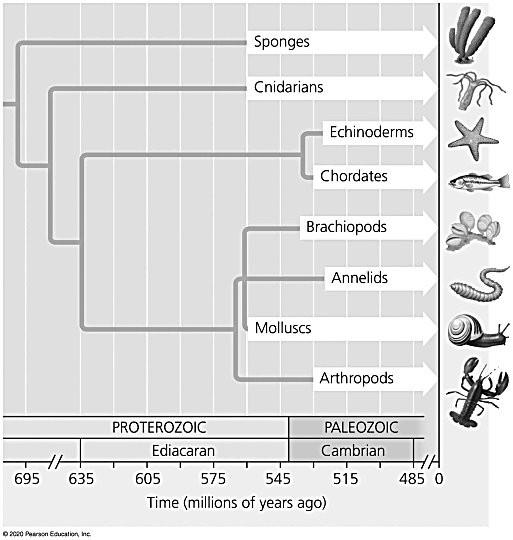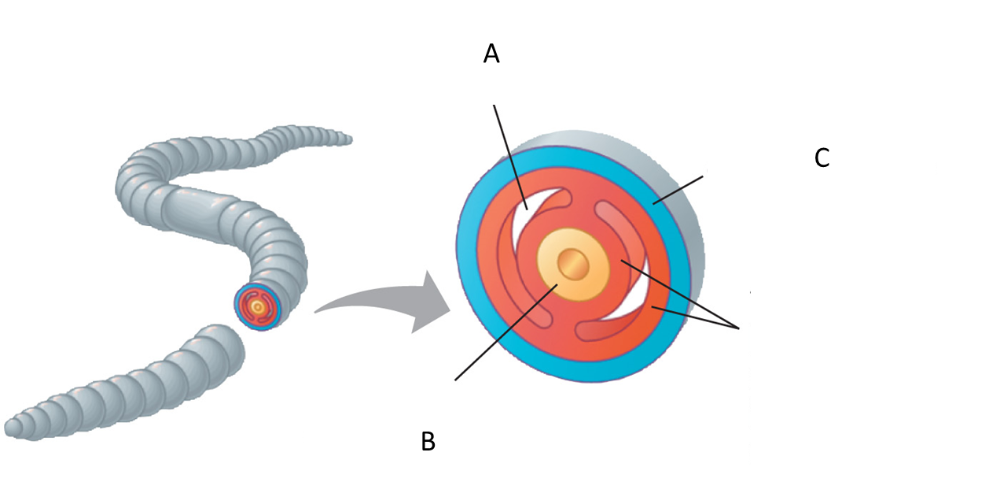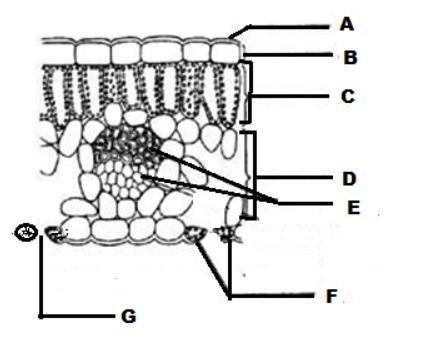Protocells are fluid filled with a surrounding membrane and contain DNA.
False
The first genetic material on early Earth was most likely
RNA.
Which of the following is an accurate characteristic of bacterial cell walls?
They prevent cells from shrinking in hypertonic environments.
Gram-positive bacteria have which characteristics?
Thick peptidoglycan layer and stain darkly
What structure protects Bacillus anthracis to survive in extreme environments like those without nutrients for decades?
Endospores
Bacteria are able to adhere to substrates and to other individuals by using fimbrae.
True
Which statement about the genomes of prokaryotes is correct?
Prokaryotic genomes are composed of circular DNA.
Which of the following describes an organism that obtains energy from light?
phototroph
Why can prokaryotic population numbers be magnitudes larger than populations of multicellular eukaryotes?
Prokaryotes are small, reproduce by binary fission, and often have short generation times.
Suppose bacteria are grown on a petri dish that contains nutrient agar and the antibiotic ampicillin. After observing the bacteria growth on the plate for two days, you notice that only some of the bacteria have survived. What is a plausible explanation for your observations?
The bacteria that survived were transformed with a plasmid that contains the resistance gene for ampicillin.
What is one key difference between transformation and conjugation?
Transformation is uptake of DNA from the environment and conjugation is exchange DNA between prokaryotes.
The main difference between endotoxins and exotoxins is that endotoxins are released when the bacterium dies, whereas exotoxins are proteins that are secreted by living bacteria.
True
The interactions of prokaryotes with humans are
both negative and positive.
Which of these observations gives the most support to the endosymbiotic theory for the origin of eukaryotic cells?
the similarity between the ribosomes of prokaryotes and the ribosomes within mitochondria and chloroplasts
Sponges are most accurately described as
filter feeders.
Ribozymes are DNA molecules that can catalyze reactions
False
Some members of this group have an "excavated" feeding groove on one side of the cell body
Excavata
Comparisons of choanoflagellate and animal genome sequences tell us that key steps in the transition to multicellularity in animals
involved new ways of using proteins or parts of proteins that were encoded by genes
Phytoplankton blooms are caused by
an abundance of nitrogen and phosphorus found in fertilizer run-off
Green algae differ from land plants in that some green algae
are unicellular.
Of the four supergroups of eukaryotes, which one contains red algae, green algae, and all land plants?
Archeplastida
The first multicellular organisms were collections of connected cells with a vast amount of differentiation
False
Which of the following are correctly described as a primary producers?
Diatoms, dinoflagellates, multicellular algae, and other protists
The life cycle of the malarial parasite, Plasmodium, includes
two stages of development: in mosquitos and humans
Sponges are most accurately described as
filter feeders.
The most ancient branch point in animal phylogeny is that between having
true tissues and no tissues.
Of the four supergroups of eukaryotes, which one contains red algae, green algae, and all land plants?
Archeplastida

Using the figure above, what is the minimum age of the common ancestor of Sponges and Cnidarians?
695 million years
Bilateral symmetry has only one imaginary slice divides the animal into two mirror-image halves
True

In the figure above, what tissue type does B refer to?
Endoderm
The body of the mollusk has three main parts: ____________________.
Visceral mass, foot, and mantle
The chorion of amniotes functions to provide
gas exchange
Marsupials are
are born early and complete development nursing from a nipple
Upright posture, bipedal locomotion, and complex tool usage traits associated with
Homo sapiens
Xylem, a vascular tissue, performs transport of food.
False
Which tissue is responsible for plant growth?
meristem
Lateral branches, thorns, or flowers on the shoot and vertical roots on the rhizome produce from the
axillary bud.
Mature cork cells deposit a waxy substance called ________ in cell walls.
suberin
Arrange the following steps of cell differentiation during plant
growth (in length) in the correct sequence.
i. cell division in
primary meristem
ii. cell division in apical meristem
iii.
differentiated cells
iv. growing cells in primary meristem
ii, i, iv, iii
If a plant is infected with nitrogen-fixing bacteria, what is the most probable effect on the plant?
It will likely grow faster than an uninfected plant.
________ is to xylem as ________ is to phloem.
Vessel element; sieve-tube member

What does 'F' represent?
Guard Cells
Which of the following is considered an organic fertilizer?
manure
Phloem transport is described as being from source to sink. Which of
the following would most accurately complete this statement about
phloem transport as applied to most plants in the late spring?
Phloem transports ________ from the ________ source to the
________ sink.
sugars; leaf; apical meristem
Epiphytes are plants that live in poor soil and digest insects to obtain nitrogen
False
The water and minerals in the xylem vessels transported by
bulk flow.
The cuticle on the surface of epidermis of leaves is an adaptation for plants to conserve
water
The dominant chemical in phloem sap is (are)
sucrose.
The cork cambium replaces which of the following tissues during the plant growth?
epidermis
The rise (upward mobility/transportation) of xylem sap by the cohesion-tension mechanism begins at the
leaves
Arrange the following stages in the life cycle of an angiosperm in a correct sequence.
i.gametophyte development
ii.double fertilization
iii.pollination
iv.seed development
i, iii, ii, iv
The products of asexual reproduction in plants are
clones, and they do not require the fusion of egg and sperm.
The function of the cotyledon is to _______
nourish the growing seedling.
Microsporangia in flowering plants are located in the
stamen
The union of a sperm cell with ________ of the female gametophyte is referred as double fertilization.
two polar nuclei
Which of the following is a multiple fruit?
pineapple
Increased success of offspring in a stable environment is considered an advantage of asexual reproduction in plants.
True
The ripening of fruit and the dropping of leaves and fruit are principally controlled by
ethylene
Why do coleoptiles grow toward light?
Auxin moves away from the light to the shady side.
Auxins play a role in ____________.
cell elongation
Young leaves and developing seeds are the prime sites for ________ synthesis.
gibberellin
A long-day plant will flower only when
nights are shorter than a certain critical value.
If a short-day plant has a critical night length of 15 hours, then which of the following 24-hour cycles will prevent flowering?
8 hours light/8 hours dark/light flash/8 hours dark
Trichomes on certain plant species are a ________ to prevent excessive herbivory.
physical defense
The radicle is the food storage for growing seedling.
False
If a plant requires pollination by bees, what adaptation would be best?
Production of nectar
During the lifecycle of an angiosperm, what type of reproduction takes place during the vegetative phase?
Asexual
Incomplete flowers lack one or more sexual organs.
True
A short-day plant will flower only when
nights are longer than a certain critical value.
What is the circulatory fluid called in arthropods with open circulatory systems?
hemolymph
If a person loses a large amount of water in a short period of time, she may die from dehydration. ADH can help reduce water loss through its interaction with its target cells in the
kidney
A collection of tissues functioning together is an
organ
The pulmonary circuit in mammals involved the flow of blood from the ______ to the ______.
heart; lungs
An example of a homeostatic response is
an increase in body temperature that results from involuntary shivering.
Which of the following develops the greatest pressure on the blood in the mammalian aorta?
systole of the left ventricle
Sparrows (a small bird species) secrete uric acid as their form of nitrogenous waste because uric acid
requires little water for nitrogenous waste disposal, thus reducing water waste.
An example of an organism that has only behavioral controls over its body temperature is the
rosy boa (a snake).
The steroid hormone aldosterone affects only a small number of cells in the body because
only its target cells contain aldosterone receptors.
How do marine fish perform osmoregulation?
through drinking water and eating food
In animals, nitrogenous wastes are produced mostly from the catabolism of
proteins and nucleic acids.
Abnormally reduced somatic growth (dwarfism) can be a consequence of decreased hormone secretion from the
anterior pituitary gland.
Coordinating body functions via release of chemical signals into the vascular system is accomplished by
the endocrine system.
What type of muscle tissue is found lining the walls of many internal organs such as blood vessels and the digestive tract?
smooth muscle
Positive feedback differs from negative feedback in that
the positive feedback's responses amplify the response rather than inhibiting it.
The function of platelets is to ___________.
blood clotting
Innate immunity
is activated immediately upon infection.
The set of blood vessels with the slowest velocity of blood flow is
the capillaries.
Engulfing-phagocytic cells of innate immunity include all of the following except
natural killer cells.
Adaptive immunity depends on
pathogen-specific recognition.
B cells have antigen receptors that bind to antigens that are either freely dissolved or present on the surface of invading/foreign cells. T cells have antigen receptors that
bind to antigen fragments presented on major histocompatibility complexes by host cells.
Antigens are
foreign molecules that trigger the generation of antibodies.
Immunological memory accounts for
the ancient observation that someone who had recovered from the plague could safely care for those newly diseased.
HIV is such a devastating virus because ____________.
it destroys helper T cells (CD4)
Antibodies function to bind and kill pathogens
False
For the successful development of a vaccine to be used against a pathogen, it is necessary that
the surface antigens of the pathogen do not change.
A key part of the humoral immune response is
the production of antibodies by plasma cells.
Activation of cytotoxic T cells requires binding to a MHC receptor on an antigen presenting cell.
True
Naturally acquired passive immunity results from the
transfer of antibodies in breast milk.
An example of a pathogen that undergoes rapid changes resulting in antigenic variation is
the influenza virus, which expresses alternative envelope proteins.
Activation of helper T cells by an antigen will directly activate
B cells and cytotoxic T cells only.
Asexual reproduction results in greater reproductive success than does sexual reproduction when
a species is in stable and favorable environments.
Environmental cues that influence the timing of reproduction usually directly affect hormone levels.
True
Which of the following patterns of reproduction are found only among invertebrate animals?
fission and budding
External fertilization often yields more offspring than does internal fertilization. However, internal fertilization offers the advantage that
the smaller number of offspring produced often receive a greater amount of parental investment.
Chemical signals released into the environment that coordinate potential reproductive partners are called
pheromones.
Among human males, both semen and urine normally travel along the
urethra.
The moment of orgasm is characterized by
rhythmic contraction of many parts of the reproductive system.
If a man is born with a blockage in his vas deferens, he may experience
low sperm count.
The primary function of the corpus luteum is to
maintain progesterone and estrogen synthesis after ovulation has occurred.
The vulva consists of the following structures. Please select all that apply
Labia majora and minora, Hymen, Clitoris
These hormone levels surge during ovulation.
FSH and LH
This male accessory gland secretes a clear mucus that neutralizes acidity in the urethra.
Bulbourethral gland
The hypothalamic hormone that triggers the secretion of follicle-stimulating hormone (FSH) is human chorionic gonadotropin (hCG).
False
If gastrulation was blocked by an environmental toxin, then
embryonic germ layers would not form.
During fertilization, the acrosomal contents
digest the protective jelly coat on the surface of the egg.
Fertilization normally
reinstates diploidy.
The vertebrate nervous system develops from the
ectoderm
Most of the neurons in the human brain are
interneurons
The cell body of a neuron contains
the nucleus and most organelles.
Efferent neurons send information to the CNS.
False
In a simple synapse, neurotransmitter chemicals are released by
the presynaptic membrane.
For a neuron with an initial membrane potential at -70 mV, an increase in the movement of potassium ions out of the cytoplasm would result in the
hyperpolarization of the neuron.
The "threshold" potential of a membrane is the
minimum depolarization needed to operate the voltage-gated sodium and potassium channels.
Action potentials move along axons
more rapidly in myelinated than in nonmyelinated axons.
________ occurs when several inhibitory postsynaptic potentials (IPSPs) arrive at the axon hillock rapidly in sequence from a single dendritic location.
Temporal summation
Receptors for neurotransmitters are of primary functional importance in assuring one-way synaptic transmission because they are mostly found on the
postsynaptic dendritic membrane.
A lobster without a statocyst would not be able to
know which way is up and which is down.
Raccoons are most active from dusk until dawn. What kinds of cells would you expect to find in the retina of a raccoon?
many more rods than cones
After earning an A in your biology course, your instructor gives you a firm handshake. You can feel the deep pressure of the handshake, and it is so strong it even starts to hurt a little. What type(s) of receptor was (were) activated by the handshake?
mechanoreceptors and nociceptors
What type of neuron would be abundant in the white matter in the brain and the white matter in the spinal cord?
myelinated axons
The system that modulates excitation and inhibition of the smooth and cardiac muscles of the digestive, cardiovascular, and excretory systems is the
autonomic nervous system.
Preparation for the "rest and digest" response includes activation of the ________ nervous system.
parasympathetic
Afferent neuronal systems include the
sensory systems.
This frontal lobe area is active when speech is generated
Broca's area
The bottlenose dolphin breathes air but can sleep in the ocean because it
alternates which half of its brain is asleep and which half is awake.
These glial cells are responsible for laying down the myelin sheaths in the central nervous system
Oligodendrocytes
These glial cells are responsible for circulating cerebral spinal fluid.
Ependymal cells
What does troponin bind to during excitation of muscle contraction?
calcium ions
The "motor unit" in vertebrate skeletal muscle refers to
one motor neuron and all of the muscle fibers on which it has synapses.
Muscle cells are stimulated by neurotransmitters released from the synaptic terminals of
motor neuron axons.
Which of the following is the correct sequence that describes the excitation and contraction of a skeletal muscle fiber?
1. Tropomyosin moves and uncovers the cross-bridge binding
sites.
2. Calcium is released and binds to the troponin
complex.
3. Transverse tubules depolarize the sarcoplasmic
reticulum.
4. The thin filaments are ratcheted across the thick
filaments by the heads of the myosin molecules using energy from
ATP.
5. An action potential in a motor neuron causes the axon to
release acetylcholine, which depolarizes the muscle cell membrane.
5 → 3 → 2 → 1 → 4
The hydrostatic skeleton of the earthworm allows it to move around in its environment by using peristaltic contractions of its circular and longitudinal muscles.
True
Animal communication involves what type(s) of sensory information?
visual, auditory, olfactory, and tactile
Chimpanzees indicate to each other that there are threats nearby by raising their arms in the air. What type of communication signal is this?
visual
Salmon are hatched in freshwater streams, and then they migrate to the ocean. When an adult salmon is ready to mate, it returns to the exact stream where it hatched. What term best applies to this behavior?
imprinting
While on a field expedition in Ethiopia, you come across a group of baboons. After watching them for several days, you notice that one male baboon frequently mates with many different females. You also don't see any other males in the group. What type of mating system best describes these baboons?
polygyny
How do altruistic behaviors arise through natural selection?
Altruism increases the likelihood that some of its genes will be passed on to the next generation.
In which form of locomotion is friction the greatest impediment to moving?
swimming
Cross fostering places the young from one species in the care of adults from another species
True
A stickleback fish will attack a fish model as long as the model has red coloring. What animal behavior idea is manifested by this observation?
sign stimulus